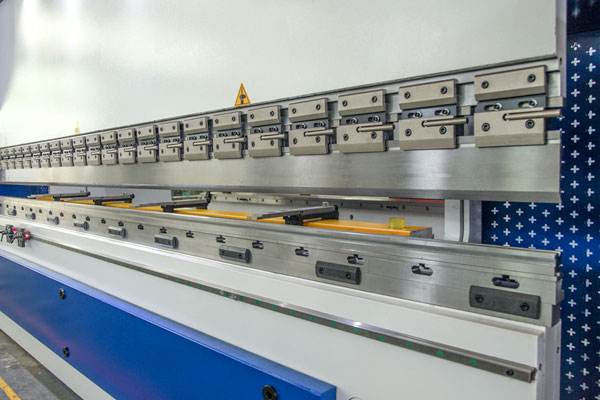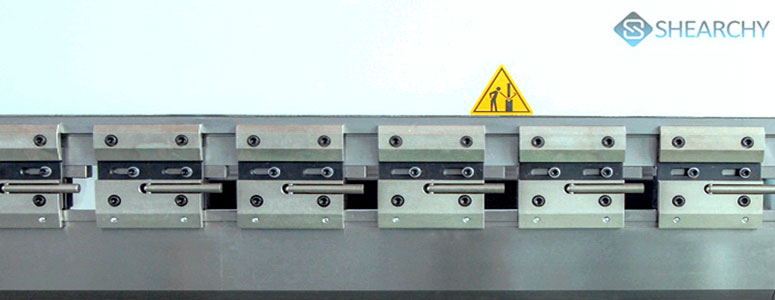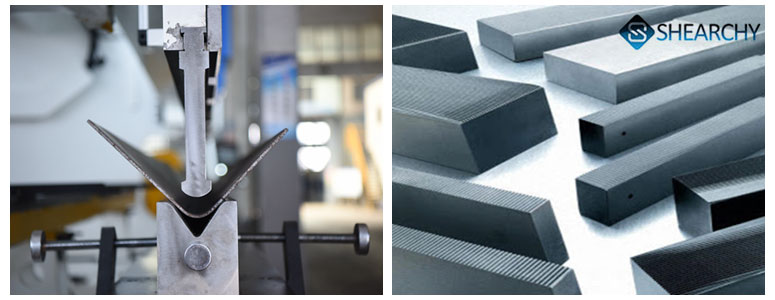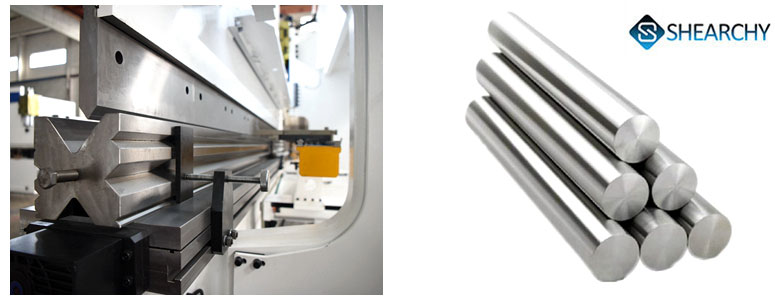Do you know what is the hydraulic press brake tooling made of? We will introduce the 9 common materials of press brake tools.
Hydraulic press brake tooling are divided into upper and lower molds of the CNC hydraulic press brake, which are used for sheet metal stamping forming and separating molds.
Generally, we use T8 or T10, T10A, and the better 42CrMo material. It mainly requires high strength, high toughness and good wear resistance.
Cold work die steel is used. Cr12MoV is a good material. The performance can be used satisfied, the process performance is good, the price will be higher. 42CrMo is a high-strength alloy quenched and tempered steel with high strength and good toughness. It can work below 500 degrees.
1. Which materials can be selected for the hydraulic press brake mold?
There are various materials for the production of hydraulic press brake tooling, including steel, cemented carbide, steel-bonded cemented carbide, zinc-based alloy, low melting point alloy, aluminum bronze, polymer materials and so on.
At present, most of the materials used to manufacture stamping CNC press brake toolings are steel.
Commonly used materials for working parts of press brake dies are:
Carbon tool steel, low alloy tool steel, high carbon high chromium or medium chromium tool steel, Medium carbon alloy steel, high-speed steel, base steel, cemented carbide, steel bonded cemented carbide, etc.
2. Carbon tool steel
The most commonly used carbon tool steels in hydraulic press brake tooling are T8A, T10A, etc.
The advantages are good processing performance and low price. However, the harden ability and red hardness are poor, the heat treatment deformation is large, and the bearing capacity is low.
3. Low alloy tool steel
Low-alloy tool steel is based on carbon tool steel with an appropriate amount of alloying elements.
Compared with carbon tool steel, it reduces the tendency of quenching deformation and cracking, improves the harden ability of steel, and has better wear resistance.
Low-alloy steels used to manufacture hydraulic press brake tooling include CrWMn, 9Mn2V, 7CrSiMnMoV (code CH-1), 6CrNiSiMnMoV (code GD) and so on.
4. High carbon and high chromium tool steel
Commonly used high carbon and high chromium tool steels are Cr12, Cr12MoV, Cr12Mo1V1 (code D2). They have good harden ability and wear resistance. The heat treatment deformation is very small for high wear resistance and micro deformation. Hydraulic press brake die steel is second only to high-speed steel in carrying capacity.
However, the segregation of carbides is serious, and repeated upsetting (axial upsetting, radial upsetting) and forging must be carried out to reduce the unevenness of carbides and improve performance.
5. High carbon medium chromium tool steel
The high-carbon medium-chromium tool steels used for hydraulic press brake clamp tooling include Cr4W2MoV, Cr6WV, Cr5MoV, etc.
They have low chromium content, less eutectic carbides, uniform carbide distribution, small heat treatment deformation, and good harden ability. And dimensional stability.
Compared with high carbon and high chromium steel with relatively serious carbide segregation, the performance is improved.
6. High-speed steel
High-speed steel has the highest hardness, wear resistance and compressive strength among die steels for hydraulic press brakes. It has a high bearing capacity. Commonly used in hydraulic press brake clamp tooling are W18Cr4V (code 8-4-1) and W6Mo5 Cr4V2 (code 6-5-4-2, US brand M2) with less tungsten content, as well as carbon and carbon reduction products developed to improve toughness.
Vanadium high speed steel 6W6Mo5 Cr4V (code 6W6 or low carbon M2). High-speed steel also needs to be forged to improve its carbide distribution.
7. Base steel
Add a small amount of other elements to the basic composition of high-speed steel, and appropriately increase or decrease the carbon content to improve the performance of the steel.
Such steel types are collectively referred to as base steel. They not only have the characteristics of high-speed steel, have a certain degree of wear resistance and hardness, but also have better fatigue strength and toughness than high-speed steel.
They are high-strength and toughness cold-work hydraulic press brake clamp die steels, and the material cost is lower than that of high-speed steel. The commonly used base steels in hydraulic press brake tooling include 6Cr4W3Mo2VNb (code 65Nb), 7Cr7Mo2V2Si (code LD), 5Cr4Mo3SiMnVAL (code 012AL) and so on.
8. Cemented carbide and steel bonded cemented carbide
The hardness and wear resistance of cemented carbide are higher than any other type of hydraulic press brake clamp die steel. But the bending strength and toughness are poor.
The cemented carbide used as the mold of the hydraulic press brake clamp is a tungsten-cobalt type. For hydraulic press brake tooling with low impact resistance and high wear resistance, cemented carbide with lower cobalt content can be selected.
For high impact hydraulic press brake tooling, cemented carbide with higher cobalt content can be used. Steel-bonded cemented carbide is made by adding a small amount of alloying element powder (such as chromium, molybdenum, tungsten, vanadium, etc.) to iron powder as a binder, using titanium carbide or tungsten carbide as the hard phase, and sintering by powder metallurgy.
The base of steel-bonded cemented carbide is steel, which overcomes the disadvantages of poor toughness and difficult processing of cemented carbide. It can be cut, welded, forged and heat treated.
Steel-bonded cemented carbide contains a lot of carbides. Although the hardness and wear resistance are lower than that of cemented carbide, it is still higher than other steel grades. The hardness can reach 68 to 73HRC after quenching and tempering.
9. New materials
The material used in the tooling of the stamping CNC hydraulic press brake belongs to the mold steel of the cold work hydraulic press brake, which is the most widely used and widely used mold steel of the hydraulic press brake. The main performance requirements are strength, toughness and wear resistance.
At present, the development trend of cold work CNC hydraulic press brake die steel is based on the performance of high alloy steel D2 (equivalent to my country’s Cr12MoV), divided into two major branches:
– One is to reduce the carbon content and the amount of alloying elements, and to increase the carbides in the steel Distribution uniformity, highlighting the improvement of the toughness of the CNC hydraulic press brake mold.
Such as 8CrMo2V2Si from Vanadium Alloy Steel Company in the United States and DC53 (Cr8Mo2SiV) from Datong Special Steel Company in Japan.
– The other is powder high-speed steel developed for the main purpose of improving wear resistance to adapt to high-speed, automated, and mass production. Such as 320CrVMo13 in Germany, etc.




